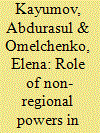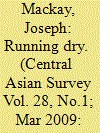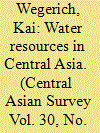|
|
|
Sort Order |
|
|
|
Items / Page
|
|
|
|
|
|
|
| Srl | Item |
| 1 |
ID:
110816


|
|
|
|
|
| Publication |
2012.
|
| Summary/Abstract |
We engage in a critical assessment of the neo-malthusian claim that climatic changes can be an important source of international tensions, in the extreme even militarized interstate disputes. The most likely scenario is conflict over water allocation in international catchments shared by poorer, less democratic, and politically less stable countries, governed by weak international water management institutions, and exposed to severe climatic changes. The Syr Darya corresponds quite well to all these characteristics. If the neo-malthusian specter of conflict over water is empirically relevant, we should see signs of this in the Syr Darya. The riparian countries of the Aral Sea basin have experienced international disputes over water allocation ever since the USSR collapsed and, with it, existing water management institutions and funding. The worst such dispute concerns the Syr Darya, one of the two largest rivers in Central Asia. Based on hydrological data and other information we find that the only existing international water management institution in the Syr Darya has failed. Based on a coupled climate, land-ice and rainfall-runoff model for the Syr Darya, we then examine whether, in the absence of an effective international water allocation mechanism, climate change is likely to make existing international tensions over water allocation worse. We find that climate change-induced shifts in river runoff, to which the Uzbek part of the Syr Darya catchment is particularly vulnerable, and which could contribute to a deterioration of already strained Kyrgyz-Uzbek relations, are likely to set in only in the medium to long term. This leaves some time for the riparian countries to set up an effective international framework for water allocation and prevention of climate-induced geohazards. By implication, our findings suggest that a climate change-induced militarized interstate dispute over water resources in Central Asia is unlikely.
|
|
|
|
|
|
|
|
|
|
|
|
|
|
|
|
| 2 |
ID:
165997


|
|
|
|
|
| Summary/Abstract |
This study examines the effect of energy resources on the chances for militarized conflict, water related conflict and cooperation events, and cooperative river treaties between pairs of states on shared international river basins. We examine trade-offs that riparian states can make between energy resources such as oil or natural gas and fresh water resources. Integrating upstream and downstream states’ geographical position in a river basin with energy resource information, we examine four related scenarios of states sharing rivers: (1) Joint energy where both upstream and downstream countries have energy resources, (2) Downstream energy where only the downstream state has energy resources, (3) Upstream energy where only an upstream country has energy resources, and (4) No energy. Theoretically, we argue that Downstream energy dyads are most likely to find cooperative solutions to conflicts over shared river resources because downstream states can offer oil and natural gas side payments to upstream states in exchange for greater water supplies. Empirical analyses of dyadic data in shared river basin dyads from 1945 to 2001 provide strong support for the theory. Riparian cooperation through river treaties and diplomacy is best achieved in Downstream energy dyads, where the downstream states have energy resources that can be traded for water resources with upstream states. Militarized conflict and water related conflict events are most likely in Joint energy dyads. Case illustrations from the Aral Sea and Ganges river basins are used to demonstrate the theoretical arguments.
|
|
|
|
|
|
|
|
|
|
|
|
|
|
|
|
| 3 |
ID:
134117


|
|
|
|
|
| Publication |
2014.
|
| Summary/Abstract |
Water as the least regulated issue is currently one of the key security factors in Central Asia. Although some efforts are made to regulate water through the establishment of a regional water regime, yet it remains unresolved. It has been stated that the involvement of international actors can have a positive effect on the solution of the problem. The analysis in this article shows that non-regional powers do not necessarily play a positive role in Central Asia. The water and energy nexus is often used by external powers as a geopolitical tool to influence regional countries for own political and economic interests.
|
|
|
|
|
|
|
|
|
|
|
|
|
|
|
|
| 4 |
ID:
087681


|
|
|
|
|
| Publication |
2009.
|
| Summary/Abstract |
The Aral Sea disaster is the result of Soviet-era irrigation policy. The collapse of the Soviet Union left the issue under the purview of international law. This essay addresses how this shift has affected attempts to slow or reverse the sea's depletion. Treaties on the non-navigation use of international watercourses and on the prevention of desertification have had little effect. While a number of regional instruments and arrangements have been brought to bear, they have also done little to reverse damage to the sea. Finally, attempts to regulate the issue through domestic law, as evidenced in the case of Kyrgyzstan, have done little as well. While some progress has recently been made under the auspices of the World Bank, it is not a result of international law. The conclusion is that the shift from domestic to international law has little improved the situation, and may have made matters worse.
|
|
|
|
|
|
|
|
|
|
|
|
|
|
|
|
| 5 |
ID:
106450


|
|
|
|
|
| Publication |
2011.
|
| Summary/Abstract |
This article explores the cooperation after independence on four Central Asian transboundary rivers. The paper shows that, even though the Central Asian states agreed in 1992 to continue with the basic water-sharing principles, new agreements had to be made. New agreements were only made in basins with large-scale water-control infrastructure, which have transboundary significance or are transboundary themselves. The inequitable water allocation between the riparian states has continued and has not triggered new agreements.
|
|
|
|
|
|
|
|
|
|
|
|
|
|
|
|
|
|
|
|
|